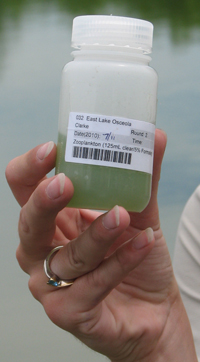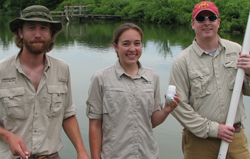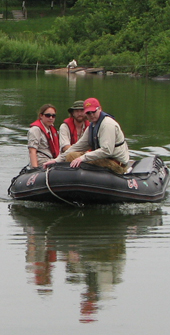AMES, Iowa - As summer days get hotter, many lakes around Iowa start to develop blue-green algae that can impair recreation and harm drinking water.
Iowa State University researchers are examining why the algae, known as Cyanobacteria, invade the lakes and what can be done about it.
John Downing, professor in the Department of Ecology, Evolution, & Organismal Biology and Department of Agricultural and Biosystems Engineering, who has led a group that has monitored water quality in 137 lakes around Iowa for more than 10 years, is installing buoys to monitor 16 lakes around the state.
"You tend to get this Cyanobacteria in water where you have a lot of nutrients, and that's Iowa," said Downing. "So here is the place to learn how to manage these things."
Iowa lakes have Cyanobacteria year round, and none of the traditional methods to clear it up have been successful, said Downing.
 Anne Patterson, a
junior in biology from Eagan, Minn., shows how green lake water
becomes during the hot summer months.
Anne Patterson, a
junior in biology from Eagan, Minn., shows how green lake water
becomes during the hot summer months.
And the problem in Iowa is much worse than comparable lakes around the globe, according to Christopher Filstrup, post-doctoral fellow in Downing's lab.
"Compared to lakes in other regions of the world, Iowa lakes have much more Cyanobacteria relative to phosphorus concentrations in the water," Filstrup said.
"At low phosphorous concentrations, lakes in other parts of the world have 5 percent Cyanobacteria concentrations," added Filstrup. "Iowa has 80 to 85 percent."
Because Iowa has such different problems, Downing is attacking the situation from a new angle.
"We are taking a new approach," Downing said. "We think the algae are caused by two things. One is that these blue-green algae are opportunistic. When we have water runoff from a big storm, we think these Cyanobacteria grab the nutrients first and start to grow.
"The other part - and where these buoys are important -- is we think the Cyanobacteria are winning the arms race to the carbon dioxide in the water. All plants need carbon dioxide to grow, except blue-green algae."
The Cyanobacteria get hold of the mineral carbon in the water, and they can unlock it and take the carbon dioxide out so nothing else can grow, according to Downing.
"We are the first people to test this," said Downing. "And if the results come out as we are pretty sure they will, we'll have big benefits for the people of Iowa and anywhere else where they have this problem."
The buoys are monitoring carbon dioxide concentration every 15 minutes to see how long the Cyanobacteria and other microscopic plants, or phytoplankton, in the lakes can go without carbon dioxide.
Downing compares it with the effect a dry spell has on a backyard garden. Plants you want in your garden can go without water for a day or two, but the longer they go without water, the fewer good plants are going to thrive and the more nasty weeds will win.
In the same way, the longer the lakes go without carbon dioxide, the more the undesirable Cyanobacteria thrive and choke off the rest of the growth.
The research is funded by the National Science Foundation and is being conducted in collaboration with the Iowa Department of Natural Resources.
Downing stresses that this collaboration of federal dollars, state agencies and university scientists is working to solve a problem that will have a direct impact on quality of life in Iowa, while creating jobs for Iowans.
The three-year study will involve two seasons of lake monitoring, and a third year to analyze the results.
Soon after that analysis, Downing thinks he and his fellow researchers will be able to make recommendations on how to control the Cyanobacteria.
"People have spent a lot of time working on this problem with little good result," said Downing. "Nobody has tried (our approach). I think we are on the right track, and we'll be able to improve the situation. This really should have positive results."
Downing has investigated how we can have productive agriculture in Iowa and still maintain water quality.
"This is an agricultural state and we are trying to make sure we have good water, too," he said.
 Jensen, Patterson
and Filstrup at East Lake near Osceola
Jensen, Patterson
and Filstrup at East Lake near Osceola
Lakes that have the monitoring devices installed are: Arrowhead Lake and Black Hawk Lake, Sac County; Badger Lake, Webster County; Beeds Lake, Franklin County; Big Spirit Lake, Center Lake, Lower Gar Lake, and Silver Lake, Dickinson County; East Lake, Clarke County; Five Island Lake and Silver Lake, Palo Alto County; George Wyth Lake, Black Hawk County; Lake Keomah, Mahaska County; Lake Orient, Adair County; Rock Creek Lake, Jasper County; and Springbrook Lake, Guthrie County.
